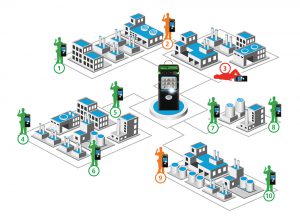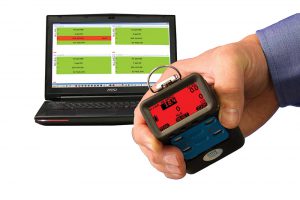Using Wireless Technology to Integrate Gas Detection and Worker Safety
Bob Henderson, Contributor
Using Wireless Technology to Integrate Gas Detection and Worker Safety
 Communication is vital when dealing with atmospheric hazards. It’s not enough to measure the hazards; procedures need to communicate the results in real time to affected workers, managers and emergency responders.
Communication is vital when dealing with atmospheric hazards. It’s not enough to measure the hazards; procedures need to communicate the results in real time to affected workers, managers and emergency responders.
The methods used to communicate monitoring results are a central part of any atmospheric monitoring program. The faster the existence of a dangerous condition is discovered and communicated to workers, supervisors and emergency responders, the less likelihood there is for property damage, injury or loss of life. When the location of the gas detector is distant from the emergency responders, timely communication of this information is even more critical.
Advances in wireless technology are making it possible to transmit information in real time between individual workers, supervisors and emergency response team members. This is particularly important for solo workers, workers in confined spaces and workers performing other risk-associated tasks. Besides being able to see readings in real time, wireless connection allows two-way communication between supervisors and instrument users. Supervisors are never out of contact, even when workers are out of sight.
The idea is to make the monitoring results immediately available to whoever needs the information, exactly where it is needed. Results can be displayed locally on a tablet, laptop, cell phone or personal computer; transmitted to a standby rescue team; or redundantly displayed on a computer or PLC, as part of the site’s environmental health and safety system. Alternatively, multiple instruments can be linked into self-contained networks controlled and integrated by means of a mobile wireless server (or host).
Connecting instruments with a remote host or terminal, by means of a wireless communication link, has long been an attractive alternative. However, concerns about the expense, dependability and robustness of the wireless link left many site managers unwilling to take a chance on this otherwise attractive technology. Over the last few years, however, changes in wireless communication technology have made wireless integration of monitoring systems increasingly feasible and attractive.
Methods for Wirelessly Communicating Gas Detection System Information
There are several different technologies which can be used for wirelessly transmitting information between portable gas detectors and a remotely located base station or information processing point.
• Bluetooth
Several portable instrument designs use a Bluetooth® transceiver built into the instrument to provide a wireless link over a limited distance between the instrument and a “smart” cellular telephone, laptop or tablet. The smart phone or tablet is used to communicate via cellular telephone or WIFI Internet connection with the information processing point, base station or terminal. The Bluetooth transceiver uses very little power, which is desirable from the standpoint of the run time of the portable instrument.
One of the limitations is the short transmission distance of the Bluetooth transceiver. Low-power Bluetooth transmission can be blocked by intervening structures and walls, and the device used to send the information onwards must be located near to the instrument. The work-around is to add repeaters or servers, which rebroadcast the information, usually at greater intensity, over a greater distance or through the intervening structural barriers.
Smart phones and tablets used to collect and transmit the monitoring information, as well as any other devices, such as repeaters and antennas, that are used in hazardous locations must carry the same certifications for intrinsic safety as the instrument. Intrinsically safe cell phones and tablets are available; but they can be expensive.
• Cellular
Some instruments include a cellular communication module installed within the instrument. This avoids the issue of needing a secondary communication device, but does not solve the problem of structures or conditions that block the transmission. Cellular telephone and WIFI connections do not work well in confined spaces or other industrial environments where walls, heavy structures and equipment can block the transmission. Once again: Repeaters, servers and/or other retransmission devices can be used to get the information out of the confined space or problem transmission area and send it onwards to the ultimate destination.
 • Radio Frequency (RF)
• Radio Frequency (RF)
In many parts of the world, (including the U.S.) instruments that include ISM band RF transmitters can be purchased and put into service without the need to obtain a radio license.
Industrial/scientific/medical (ISM) RF transmitters send a short, high-speed stream of digital packets of information at one frequency, then “hop” to another frequency to transmit the next stream of data packets. Part of the information encoded in the string of packets is the frequency where the receiver (or transceiver) should look for the next string. It is possible to maintain seamless communication between the base controller and remotely located detectors, even when there is significant loss of individual strings of information. This is due to the heavy redundancies in the information transmitted in the digital strings and multiple fallback frequencies encoded in the string, in case of a failure to receive the next stream of information at the expected frequency. This type of technology also makes it much easier for multiple users to share the same frequency range. It is nearly impossible for one transmitter to “step on” or block another transmitter’s signal.
• Servers, Base Stations and Hosts
The wireless receiver (or transceiver) and software can be installed or plugged into a laptop, tablet or personal computer, in which case the monitoring information is displayed directly on the computer screen or LCD. Use of a laptop or tablet allows the full display of readings, status and alarm state information. The computer or tablet can also function as a communication hub, with digital communication outputs that allow information to be redistributed to additional remote locations.
Another approach is to use a dedicated wireless “server” to integrate the monitoring results from multiple instruments. Portable, wireless gas detection system servers are usually designed (and certified) for use in hazardous locations and can handle environmentally harsh conditions. The server includes a display, as well as audible and visual alarms, and indicators that show the communication status of the instruments being included in the system.
Generally, wirelessly integrated systems are based on RF transceivers that can both send and receive system information. The base controller transceiver constantly monitors to ensure that all remotely located detectors, remote alarms and other RF-enabled system components are in proper communication with the wireless server. Loss of communication between system elements can be detected almost immediately and used to generate the appropriate local and general alarms.
Real Time Wireless Communication Leads to Enhanced Worker Safety
Wireless technology substantially improves the ability of supervisors to maintain communication with entrants; to alert workers if there is a need to evacuate the area; and to coordinate rescue activities. Wireless communication provides a particular benefit where, in the event of an emergency, rescue services are to be provided by a third-party provider. The timeliness in sounding the alarm and/or activating the response team is crucial to the ability of the team to successfully respond to the incident.
When it comes to worker safety, it’s not enough just to monitor the conditions in the atmosphere. It’s what you do with the information that counts. Using wireless technology to distribute information in real time to the people and places where it is needed is transforming workplace safety. The wireless revolution is here to stay. IHW
Share on Socials!
Ventilation Troubleshooting: Before You Call the Engineer
Spotlighting OSHA’s Lead Standards: Proposed Updates & Implications
Respirator Fit-Testing Methods (ANSI/AIHA/ASSE Z88.10-2010)
Leaders in Industrial Hygiene
Council for Accreditation in Occupational Hearing Conservation (CAOHC)
Subscribe!
Sign up to receive our industry publications for FREE!









